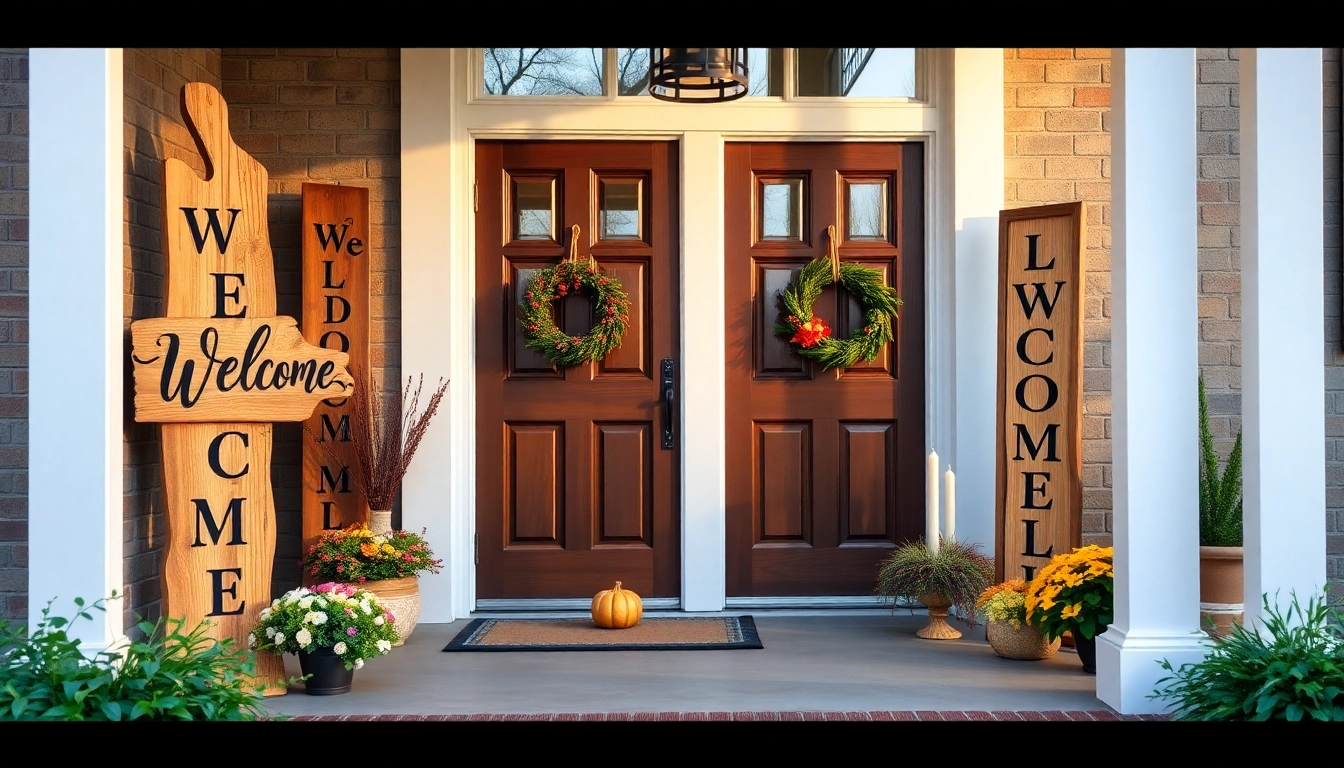
Creative Ways to Design Custom Welcome Signs That Truly Invite Guests
Understanding the Role of Welcome Signs in Home and Business Decor
Welcome signs play a pivotal role in setting the tone for any space, whether it’s a cozy home or a bustling business. These decorative pieces serve as visual invitations, immediately conveying warmth, hospitality, and personality. In an increasingly competitive landscape of decor options, well-designed welcome signs can differentiate your space, making guests and customers feel appreciated and at ease from the moment they arrive. Their strategic placement at entry points—such as front doors, porches, or reception areas—further amplifies their impact, functioning as both functional markers and aesthetic enhancements.
In addition to their decorative value, welcome signs also reflect the homeowner or business owner’s style and values. From rustic farmhouse appeal to sleek modern minimalism, the variety of styles available allows for customization that aligns with personal or brand identity. Moreover, a thoughtfully chosen welcome sign complements overall entryway decor, tying together elements like lighting, furniture, and landscaping into a cohesive presentation.
For anyone aiming to make a positive first impression—whether for visitors, clients, or customers—integrating a high-quality, personalized welcome sign is a proven strategy. This article explores the significance of welcome signs, offers guidance on selecting and customizing them, provides DIY insights, and reviews where to purchase high-end options to elevate your space.
Why Welcome Signs Make a Lasting First Impression
The first moments someone encounters your home or business can significantly influence their perception. Welcome signs serve as the physical embodiment of your hospitality and style. A well-designed sign immediately communicates friendliness and attentiveness, creating an inviting atmosphere that encourages positive interactions.
Research in environmental psychology indicates that first impressions are formed within milliseconds and are heavily influenced by visual cues. An appealing welcome sign acts as a social signal—indicating that the space is cared for, safe, and thoughtfully curated. For businesses, especially retail stores, restaurants, or hospitality establishments, this initial visual cue can influence customer behaviors, encouraging longer visits and repeat patronage.
Moreover, the tone set by your welcome sign can align with branding goals. For example, a rustic wooden sign conveys warmth and tradition, ideal for country inns or farm-to-table restaurants, while sleek metallic signs project modern sophistication suitable for upscale boutiques or corporate offices. The customization possibilities allow you to craft an experience that resonates precisely with your target audience.
Case Study: How a Personalized Welcome Sign Boosted Curb Appeal
Consider a small family-owned café that revamped its entrance with a customized wooden sign featuring hand-painted lettering and seasonal motifs. Within months, the café reported increased foot traffic, attributable in part to improved curb appeal. Its rustic charm attracted passersby, and the sign’s seasonal updates kept the entrance fresh and engaging, fostering a sense of community and warmth.
Types of Welcome Signs: From Rustic to Modern Styles
The diversity of welcome signs reflects the broad spectrum of interior and exterior decor themes. The primary categories include rustic, modern, vintage, farmhouse, coastal, industrial, and personalized styles. Selecting the right type necessitates aligning with your overall aesthetic, intended ambiance, and functional needs.
Rustic Welcome Signs
Rustic welcome signs often feature reclaimed wood, distressed finishes, and handcrafted elements. They evoke warmth, nature, and simplicity, making them ideal for country homes, cabins, or outdoor eateries. These signs may incorporate natural textures, earthy tones, and handcrafted fonts to reinforce their organic appeal.
Modern Welcome Signs
Modern signs favor clean lines, minimalistic designs, and contemporary materials such as metal or acrylic. They are typically characterized by sleek typography and monochromatic palettes, perfect for urban dwellings, chic boutiques, or corporate offices seeking a streamlined look.
Vintage and Retro Signs
Vintage welcome signs display nostalgic charm, often featuring retro fonts, faded paint effects, or antique-inspired motifs. They can add personality and a sense of history, appealing to spaces that aim to evoke a bygone era.
Farmhouse and Coastal Styles
Farmhouse signs utilize distressed wood, white-washed finishes, and often feature playful or heartfelt messages. Coastal signs incorporate nautical motifs, light blues, and sandy hues, bringing a breezy, relaxed vibe to the entrance.
Customization and Versatility
Regardless of the style, many welcome signs are customizable with personal messages, family names, or business branding. This flexibility enhances their ability to match any decor and purpose, from weddings and special events to daily home decoration.
The Psychology Behind Inviting Entryway Decor
Entrances that feature appealing welcome signs tap into fundamental psychological principles related to hospitality and social bonding. The presence of a warm, personalized sign signals to visitors that they are anticipated and valued, reducing social anxiety and creating a sense of belonging.
Color psychology plays a prominent role; warm colors like reds, oranges, and yellows evoke friendliness and enthusiasm, while cooler shades such as blues and greens impart calm and trustworthiness. The choice of font and design elements also influences perceptions—friendly, rounded fonts foster approachability, whereas clean, sans-serif fonts communicate professionalism.
Furthermore, seasonal or themed signage demonstrates attentiveness and adaptability, making guests feel welcomed regardless of the time of year or event context. The strategic use of humor, heartfelt messages, or cultural symbols can deepen emotional connections, turning a mere decorative element into an effective branding or personal expression tool.
Choosing the Perfect Welcome Sign for Your Space
Materials and Durability for Outdoor Use
Outdoor welcome signs are exposed to the elements, so selecting durable materials is crucial. Popular options include reclaimed wood, metal (aluminum, steel, or wrought iron), acrylic, and weather-resistant composites. For instance, metal signs coated with powder finishes resist rust and fading, making them suitable for prolonged outdoor use.
Wooden signs should be crafted from rot-resistant species like cedar or treated pine for longevity. Additionally, protective sealants and weatherproof paint ensure that colors stay vibrant and materials withstand rain, snow, and UV exposure.
Size, Color, and Design Considerations
The size of your welcome sign should be proportionate to your entryway. A large sign commands attention from a distance, ideal for grand entrances, while smaller signs suit cozy porches. Color choices should complement existing exterior palettes; contrast enhances readability, and harmonious tones create visual unity.
Design elements, including fonts and graphics, must be legible from various distances. Simple, bold fonts tend to be more effective, especially for outdoor signs. Incorporating decorative borders or accents can elevate the aesthetic without cluttering the message.
Personalization Options to Match Your Aesthetic
Customization allows tailoring the message, font style, and decorative elements to suit personal taste or brand identity. Options include monogramming, incorporating family names or logos, or adding seasonal motifs. Digital printing, hand-painting, or engraving methods offer different textures and finishes, each adding unique character.
DIY Tips for Creating Unique Welcome Signs
Materials and Tools You’ll Need
Creating your own welcome sign can be both rewarding and cost-effective. Essential materials include a base surface (wooden plank, metal sheet, or acrylic panel), paint or stain, brushes or spray paint, stencils (if desired), and sealing finishes. Tools such as drills, saws, and sanders are useful for crafting custom shapes or etching details.
Step-by-Step Guide to Crafting Your Sign
- Design Planning: Sketch your design, considering typography, layout, and motifs. Use graph paper or digital tools for precision.
- Prepare the Base: Cut and sand your material to desired dimensions. Ensure a smooth surface for painting or engraving.
- Apply Base Coats: Seal or stain the background as desired. Allow drying time.
- Paint or Etch: Use stencils or freehand your message. Multiple coats may be necessary for vivid colors.
- Finish and Seal: Protect your work with outdoor-grade sealants, especially if the sign will be exposed to weather.
Adding Personal Touches and Seasonal Elements
Enhance your sign with decorative embellishments—ribbons, faux floral arrangements, or seasonal symbols like pumpkins or snowflakes. Using interchangeable elements, such as chalkboard sections or magnetic pieces, allows flexibility for seasonal updates without replacing the entire sign.
Where to Buy Premium Welcome Signs and Custom Orders
Top Online Retailers and Local Artisans
Numerous reputable sources provide high-quality welcome signs suitable for various tastes and budgets. Leading online options include iCustomLabel, which offers customizable signs designed specifically for porch and entryway decor. Other notable sources are Amazon, Etsy, and specialized local artisans who craft personalized pieces, ensuring uniqueness and craftsmanship.
Advantages of Custom vs. Pre-Made Signs
Pre-made signs are typically less expensive and ready to ship, making them ideal for quick updates or seasonal changeovers. however, custom signs provide bespoke messaging, personalized designs, and materials; they align more closely with your aesthetic and branding needs, making them a lasting investment.
Budget-Friendly Tips for High-Impact Decor
To maximize impact without overspending, consider DIY approaches, repurposing vintage finds, or ordering custom signs during sales. Incorporating seasonal decorations or interchangeable elements can also keep your decor fresh and engaging at minimal cost.
Maintaining and Updating Your Welcome Sign Over Time
Cleaning and Preservation Tips
Routine cleaning with gentle soap and water preserves the appearance and functionality of outdoor signs. For wooden signs, periodic re-sealing with weatherproof finishes prolongs lifespan. Metal signs may require rust treatment and repainting if corrosion appears.
Seasonal Changes and How to Refresh Your Sign
Updating seasonal motifs or messages keeps your welcome sign relevant and appealing. Consider adding removable accessories like chalkboard sections or magnetic decor. For example, a fall-themed wreath or holiday banners can be swapped in and out to match seasons or festivities.
Signs as Part of Overall Entryway Styling
A welcome sign should coordinate with lighting fixtures, planters, mats, and furniture to create a harmonious entryway. Periodic evaluations and updates to these surrounding elements further enhance curb appeal and reflect evolving style preferences.


